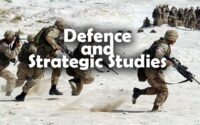Defence and Strategic Studies Practice Question
1. Unification of Germany represent a success of :
(A) Fundamentalism
(B) Nazism
(C) Nationalism
(D) Separatism
2. Place the following Soviet leaders in a chronological order :
(1) Khrushchev
(2) Brezhnev
(3) Gorbachev
(4) Stalin
(5) Andropov
(A) (4), (1), (2), (5), (3)
(B) (1), (4), (3), (5), (2)
(C) (4), (1), (2), (5), (3)
(D) (1), (2), (4), (5), (3)
3. Which of the following statement about China are correct ?
(A) China is not a member of the NPT but has accepted the no first use policy
(B) China is a member of the NPT since 1968 and has supported actions against Iran and North Korea
(C) China became a member of the NPT in 1992 and is a supporter of the no first use policy
(D) China became a member of the NPT in 1992 and continuous to opposite the no first use policy
4. In the United Nations system the primary role of maintaining peace and security rests with the :
(A) Permanent members of the Security Council
(B) Security Council
(C) General Assembly
(D) Secretary General
5. The largest ethnic group in Afghanistan is :
(A) Pashtun
(B) Tajik
(C) Hazara
(D) Uzbek
6. Kyoto Protocol calls for the reduction of greenhouse gas emission by ……………. by 2012.
(A) 15%
(B) 10%
(C) 5%
(D) 7.5%
7. McMahon line was finalised in :
(A) Simla Agreement, 1914
(B) Panchsheel Agreement, 1954
(C) India-China Agreement, 1949
(D) Shimla Agreement, 1971
8. Tahrir Square that came in the news in 2010 is in :
(A) Tunisia
(B) Lybia
(C) Egypt
(D) Yemen
9. CIS emerged after :
(A) End of British colonialisation
(B) Dissolution of Warsaw Pact
(C) Disintegration of Yogoslavia
(D) Disintegration of the Soviet Union
10. ‘‘String of Pearls’’ refers to a strategy designed by :
(A) India
(B) China
(C) Pakistan
(D) United States
11. Supply chain is a link between :
(A) Natural resources and consumption of material by men in the theatre of war
(B) Natural resources and industry
(C) Industry and market
(D) Market goods and consumers
12. What was the main mode of transportation in forward areas during the India-China War of 1962 ?
(A) Road
(B) Rail
(C) Air transport
(D) Waterways
13. Sri Lankan conflict can be considered as :
(A) Popular uprising
(B) Religious conflict
(C) Ethnic conflict
(D) Social conflict
14. International conflict after 1991 have been mainly based on :
(i) State restructuring
(ii) Ethnic unrest
(iii) Disarmament
(iv) Religious resurgence
(A) Only (i) and (ii) are correct
(B) Only (i), (ii) and (iv) are correct
(C) Only (i) and (iv) are correct
(D) All the four are correct
15. Kenneth Waltz classifies the major sources of war as arising from :
(i) Human nature
(ii) Internal structure of states
(iii) International Anarchy
(A) Only (i) is correct
(B) Only (i) and (ii) are correct
(C) Only (iii) is correct
(D) All the three are correct
16. What do you understand by ‘Positive Peak’ ?
(i) Absence of war
(ii) Absence of violence
(iii) Absence of direct violence
(iv) Absence of indirect violence
(A) Only (i) and (ii) are correct
(B) Only (ii) and (iii) are correct
(C) Only (iii) and (iv) are correct
(D) Only (ii), (iii) and (iv) are correct
17. ‘Post-conflict peace building action’ was a concept spelt out by :
(A) U. Thant
(B) Boutrous Boutrous Ghali
(C) Dag Hammerskjold
(D) Kofi Annan
18. The following organisation enjoys neutrality in war :
(A) Amnesty International
(B) UNHRC
(C) Red Cross Society
(D) Green Peace
19. India-Pakistan peace initiatives are based on :
(A) Geographic mapping
(B) Military exercises
(C) Deterrence
(D) CBM
20. Lahore Declaration (1999) was signed between :
(A) Afghanistan—Pakistan
(B) India—Pakistan
(C) Bangladesh—Pakistan
(D) China—Pakistan
| GK | Previous Papers |
| Practice Question | Quiz |
| Mock Test | Objective Papers |
| Old Question | MCQs |
| Sample Papers | UGC NET Solved Papers |
| Model Question |
21. Countries defined as hearing threshold power relate to what amongst the following :
(A) Food security
(B) Industrial capability
(C) Nuclear weapons capacity
(D) Big power status
22. Read the following statements regarding development in science and technology and their application in war. Which of the statements is not correct ?
(A) Whitney manufactured the first mass production markets in the US in 1798
(B) The ‘‘Turtle’’ was used in the American Civil war by Sergant Lee to go down the Hudson river
(C) Fulton’s wood and iron clad submarine was called Nautilus
(D) American civil war saw the first use of Zepplin, the air baloon
23. Ricardo argued that :
(A) Wars should be financed by loans
(B) Wars result in loss of human capital
(C) War helped to check population growth
(D) Wars should be financed by taxes alone
24. Read the following statements about offensive and defensive technologies :
(i) Few technologies are purely offensive or purely defensive
(ii) The relationship between offence and defence is complex, what is defensive can be used in an offence way or vice versa
(iii) Most weapons are built to implement tactics
(A) Only (i) is correct
(B) Only (i) and (ii) are correct
(C) Only (iii) is correct
(D) All the three are correct
25. The stealth aircraft is an example of development in :
(A) Nuclear Technology
(B) Materials Technology
(C) Biotechnology
(D) Information Technology
26. Dhruv is India’s indigenously developed :
(A) Light Combat Aircraft
(B) Advance Helicopter
(C) Short Range Missile
(D) Medium Range Missile
27. ‘‘Arihant’’ refers to India’s indigenously developed :
(A) Light Combact Aircraft
(B) Main Battle Tank
(C) Nuclear powered submarine
(D) Communication satellite
28. ‘Strategic Command’ in India refers to
(A) Command and control of nuclear weapons
(B) India’s Indian Ocean maritime domain
(C) Aerospace power
(D) Army’s Northern Command
29. SAPTA deals with the following issue :
(A) Political
(B) Cultural
(C) Trade
(D) Technology
30. RMA refers to :
(A) use of nuclear technology
(B) use of conventional technology
(C) use of technology in warfare
(D) use of biological weapons
31. Strategy is about:
(A) military campaigns
(B) use of military power to achieve political objectives
(C) use of military power to achieve strategic superiority over the enemy
(D) use of nuclear weapons in war
32. Features of a nation are:
(i) Demographic and cultural similarities
(ii) Feeling of a community
(iii) Desire to be politically separate
(A) only (i) is correct
(B) only (iii) is correct
(C) only (i) and (ii) are correct
(D) all three are correct
33. The concept of equal security:
(i) was spelt out at the 1972 USUSSR Moscow summit
(ii) US and USSR agreed to respect each other’s legitimate interests
(iii) was spelt out at the 1961 nonaligned summit at Belgrade
(iv) Third world countries wanted to be treated on the basis of equality
(A) only (iii) and (iv) are correct
(B) only (i) and (ii) are correct
(C) only (i) and (iii) are correct
(D) all the four are correct
34. Collective security as a security strategy is based on the following approach:
(A) Liberal/Idealist
(B) Realist
(C) Systems
(D) Critical theory
35. Geographic power potential is magnified or constrained by:
(A) Political leadership
(B) Natural resources
(C) Trade
(D) Technology
36. Paramilitary forces come under the following:
(A) Prime Minister’s Office
(B) Ministry of Defence
(C) Ministry of Home
(D) National Security Council
37. The origins of detente can be traced to the lessons of:
(A) Use of atomic weapons in Hiroshima and Nagasaki
(B) The Cuban missile crisis
(C) Nixon’s visit to China in 1972
(D) Soviet intervention in Afghanistan in 1979
38. Who is the Supreme Commander in the Higher Defence Structure of India:
(A) President
(B) Prime Minister
(C) Defence Minister
(D) Chairman of Integrated Staff Committee
39. The concept of ‘lines of operation’ was emphasised by:
(A) Jomini
(B) Clausewitz
(C) Douhet
(D) Mahan
40. For achieving seaworthiness six determinants were indicated by:
(A) Mahan
(B) Howard Michael
(C) Liddell Hart
(D) Jenkins
41. The concept of human security was first initiated by:
(A) Canada
(B) The United States of America
(C) China
(D) Australia
42. A limited war:
(i) has a specific political goal
(ii) attempts to affect the opponents’ will and not crush it
(iii) does not seek unconditional surrender
(iv) is conducted with tactical nuclear weapons
(A) only (i) and (iii) are correct
(B) only (i), (ii) and (iv) are correct
(C) only (ii), (iii) and (iv) are correct
(D) only (i), (ii) and (iii) are correct
43. Willy Brandt’s report ‘North-South: A Programme for Survival’ considered:
(A) disarmament as a strategy for development
(B) NPT as a discriminatory treaty
(C) Supported Ronald Reagan’s ‘Strategic Defence Initiative’
(D) Supported Gorbachev’s ‘Perestroika’ as an approach to development
44. The rationale for the creation of SEATO and CENTO was:
(A) establish US hegemony in the Asia-Pacific region
(B) Provide security to US Naval bases in the Indian ocean region
(C) Prevent the spread of communism in Asia
(D) Break the Sino-Soviet alliance
45. In the context of Indo-US relations the Kicklighter proposals represent the:
(A) finalisation of the Indo-US Civilian Nuclear Co-operation agreement
(B) beginning of Indo-US dialogue on Global Warming
(C) Efforts made by the US to pressurise India to join the NPT
(D) beginning of Indo-US strategic dialogue
46. Humanitarian intervention:
(i) is a military intervention carried out in pursuit of humanitarian rather than strategic objectives
(ii) presumes the acceptance of such universal doctrines as human rights
(iii) gets support from the people as it is fought for a moral cause
(A) only (i) is correct
(B) only (i) and (ii) are correct
(C) only (ii) and (iii) are correct
(D) all three are correct
47. The American concept of ‘Global war on Terror’ evolved after:
(A) the Iraqi invasion of Kuwait
(B) the 9/11 attack
(C) The failure to capture Osamabin-Laden in Afghanistan
(D) The Soviet inervention in Afghanistan in 1979
48. Francis Fukuyama’s thesis of ‘‘End of History’’ sought to celebrate the triumph of:
(A) Socialism
(B) Neomercantalism
(C) Liberalism
(D) Democratic socialism
49. Which of the following five countries were recognized nuclear weapon states at the time of the creation of the NPT?
(A) India, Pakistan, US, USSR, UK
(B) US, UK, USSR, China, India
(C) US, UK, USSR, France, India
(D) US, UK, France, USSR, China
50. Which one of the following is an essential component of conventional deterrence?
(A) Attrition
(B) Blitzkrieg
(C) Mass retaliation
(D) Limited war

